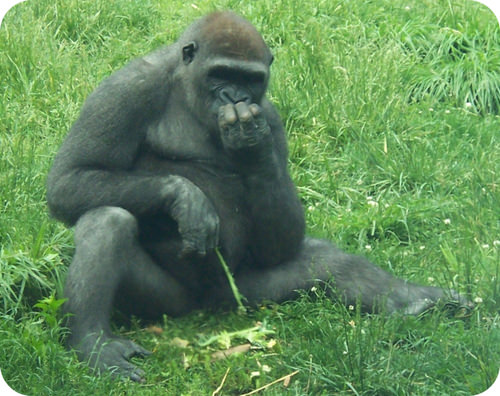10.25: Primates and Humans
- Page ID
- 14178

What animals are humans' closest cousins?
Looking at our evolutionary tree, our closest relatives include the orangutans pictured here. Notice the way this mother cradles her child; they look very human-like. Orangutans are also highly intelligent. Notice the detail in the hand. In the wild, they can create and use tools.
Humans and Primates
The great apes are the members of the biological family Hominidae, which includes four living genera: chimpanzees, gorillas, orangutans and humans. Among these four genera are just seven species, two of each except humans, which has only one species, Homo sapiens.
Characteristics
The Great Apes are large, tailless primates, ranging in size from the pygmy chimpanzee, at 66-88 pounds in weight, to the gorilla, at 300-400 pounds (Figure below). In all species, the males are, on average, larger and stronger than the females.

Most living primate species are four-footed, but all are able to use their hands for gathering food or nesting materials. In some cases, hands are used as tools, such as when gorillas use sticks to measure the depth of water (Figure below). Chimpanzees sharpen sticks to use as spears in hunting; they also use sticks to gather food and to “fish” for termites.

Most primate species eat both plants and meat (omnivorous), but fruit is the preferred food among all but humans. In contrast, humans eat a large amount of highly processed, low fiber foods, and unusual proportions of grains and vertebrate meat. As a result of our diets, human teeth and jaws are markedly smaller for our size than those of other apes. Humans may have been eating cooked food for a million years or more, so perhaps our teeth adapted to eating cooked food.
Gestation (pregnancy) lasts 8-9 months and usually results in the birth of a single offspring. The young are born helpless, and thus, they need parental care for long periods of time. Compared with most other mammals, great apes have a long adolescence and are not fully mature until 8-13 years of age (longer in humans). Females usually give birth only once every few years.
Gorillas and chimpanzees live in family groups of approximately five to ten individuals, although larger groups are sometimes observed. The groups include at least one dominant male, and females leave the group when they can mate. Orangutans, however, generally live alone.
Genetic and Behavioral Similarities
Gorillas, chimpanzees, and humans have more than 97% of their DNA sequence in common. This means that a similar percent of the amino acid sequences of the proteins will be the same, resulting in many proteins with similar or identical functions.
All organisms in the Hominidae communicate with some kind of language. They can also create simple cultures beyond the family or group of animals. Having a culture means that knowledge and behaviors can be passed on from generation to generation.
Specialized Human Features
Specialized features of Homo sapiens include the following:
- small front teeth (canines and incisors) and very large molars relative to other primate species,
- a fully upright posture resulting in bipedalism (walking on two limbs instead of four),
- shortening of the arms relative to the legs,
- increased usefulness (dexterity) of the hands,
- increase in brain size, especially in the frontal lobes
- and a decrease in bone mass of the skull and face.
See Communication - the Jane Goodall Institute at http://www.janegoodall.org/chimpanzees/communication, and Discovering Gibbons at http://www.youtube.com/watch?v=C6HucIWKsVc for additional material.
Summary
- The biological family Hominidae includes four living genera: chimpanzees, gorillas, humans, and orangutans.
- Gorillas, chimpanzees, and humans have more than 97% of their DNA in common.
- All organisms in the family Hominidae can develop language and culture.
Explore More
Use the resources below to answer the questions that follow.
Explore More I
- Human and Primate Relationship' at http://www.youtube.com/watch?v=i8PNWZDhGq4 (1:21)
- Where do chimpanzees (Pan troglodytes) live geographically?
- What tool are the chimpanzees in the video using?
Explore More II
- Silverback Gorilla and Family at http://www.youtube.com/watch?v=l1GZC3lQGbg (2:51)
- What do gorillas do when they approach each other or feel other gorillas are around?
- Who is the leader of a gorilla family?
Explore More III
- Amazing DIY Orangutans at http://www.youtube.com/watch?v=IFACrIx5SZ0 (2:41)
- Are the orangutans in the video displaying learned or innate behavior? Explain your answer.
Review
- What organisms share the same biological family as humans?
- Why do chimpanzees and humans have many similar proteins?
- What is important about a primate culture?
- What are three specialized human features?

